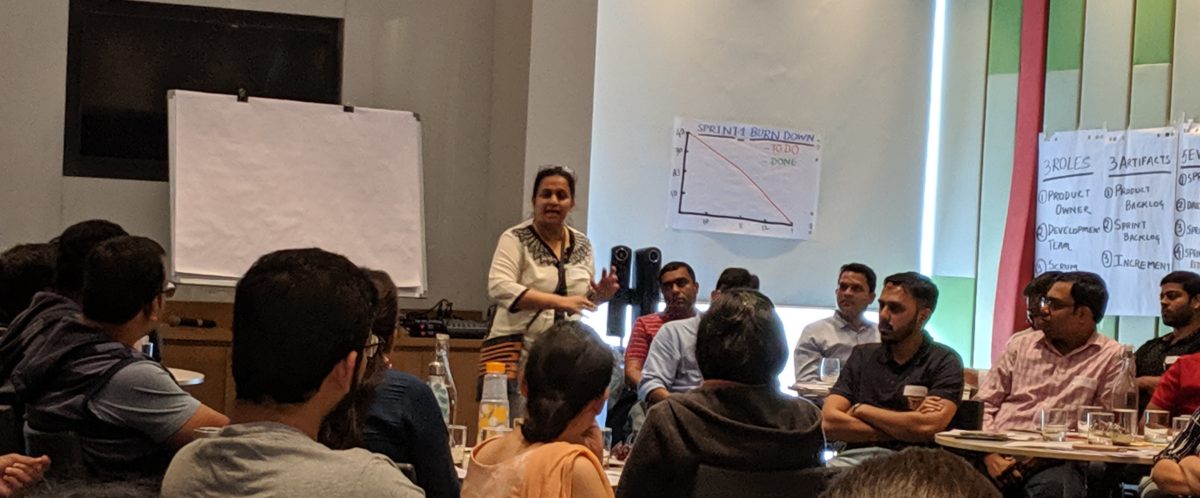Common Misconceptions
People think that just by moving to Scrum all their issues will get resolved and magically all timelines will be met, no budgets will ever get overrun, all people will be happy, all customers will be happy, all changes come free and so on….
What Really is Scrum?
Scrum is a framework for solving Complex Adaptive Problems. Complexity means “Unknown-ness”. The Unknowns can be on requirements or on solutions. Where things are unknown, you cannot make detailed plans and just track the plan to closure. In such situations where things are unknown, what you see in front of you can be the only decision factor. Taking decisions based on what you see and constantly Inspect and Adapt based on what you see is called “Empiricism” or “Empirical process Control”. Scrum is a framework which sits on the “Empirical Process Control Theory”. For known problems (requirements known and solutions known), you will not need the inspect-adapt approach. The approach used for known problems is called “Defined Process Control”. Waterfall framework is based on “Defined Process Control”
Recommendations
One must understand that Scrum does not necessarily reduce cost and timelines. In Empirical process control, there will always be a feedback structure since the decisions are taken based on what you see. That means, we think about short-term in detail and long-term at a high level. When we see the results of short-term, we get feedback and then we inspect and adapt based on what we see. Therefore, there may be repetitions due to the feedback structure. Repetitions may mean that some re-work may happen. One must not think that just by doing Scrum, the cost and time will be lesser. If we use Scrum for problem statements which could have been solved using waterfall (or Defined process control), then unnecessary overheads and unnecessary inspect-adapt cycles may increase the cost and timelines. My recommendation is to choose the right framework for the right purposes. Taking a “one-size-fits-all” is not a great idea.
The teams are not necessarily happy doing Scrum. In the Scrum way of doing things, the timeframes are short. Delivery cycles shrink to a few week cycles. There is a constant pressure on teams. Many times, you will notice comments in the team like “Waterfall was better”. Scrum is actually Pervasive. That means people don’t like this drastic change in their lives. This change touches people’s lives. My recommendation is to ensure that every organization first implements a culture which sustains this pressure. The earlier model, where there was “push culture” should change first. Management should not create unnecessary pressure on the teams. Agile principle number 8 should be implemented first “Agile processes promote sustainable development. Sponsors, Developers and Users should be able to maintain a constant pace indefinitely”
The business teams are not necessarily happy doing Scrum. The Business teams were used to pushing accountability conveniently on the technical team’s side under the umbrella of a few terms like “Managed Services” or “Managed Outcomes”. The IT companies also marketed these terms like “Managed Services” to create differentiators for themselves. The Business teams suddenly start feeling the heat when they are held accountable for ensuring that the delivery happens properly and making sure that they have to work with the technical teams on a day-to-day basis. In Scrum, we define the accountability “Product Owner” where participation from a Business perspective is extremely important. My recommendation that the Business Teams must be made to understand that Accountability cannot be outsourced and one cannot toss the accountability on the technical side. The business should be brought in sync with the Agile principle “Business People and Developers must work together daily throughout the project”. Scrum emphasizes that the right people take the right accountability and accountability cannot be outsourced.
The Business teams have conveniently understood that “Changes are free in Agile and Scrum”. One has to understand that no changes are ever free. There is always a cost associated with a change. It is just differently looked at in Scrum. In Scrum, we tend to give importance to more valuable features. That means, the less valuable features go down the product backlog and may never get implemented. So, pushing the teams to do all requirements may not be a great idea, else the cost will obviously go up. My recommendation is to follow the Agile principle number 10 which says “Simplicity – The art of maximizing the work NOT done is essential”. The business has to know that nothing in this world is free and we need to learn to compromise less-value features for the more valuable ones
Conclusion
Scrum is not a magic-wand solution to solving all problems. In fact, if you do things incorrectly then the problems will multiply. It is better for organizations to understand Scrum and Agile correctly and apply only where required. “One-size-fits-all” is not a great approach.
